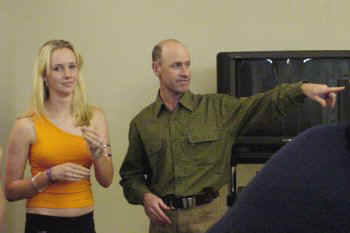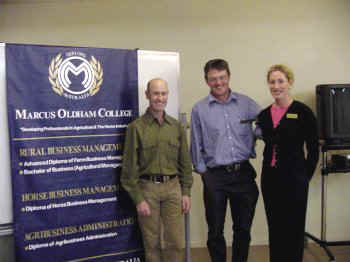| Eventing News |
|
Physically Andrew considers the feet to be very important. At three and four star level there is a lot of stress on the structural and soft tissue of the hoof. 80% of problems occur below the knee and those above the knee are usually related to foot placement. If Andrew sees a horse with big, flat feet and it is low in the heel - he won't even sit on it. Finally he always gets a vet check, x-rays and always takes a blood sample Thoroughbreds are Andrew's horse of choice. He feels that Australian thoroughbreds are generally hotter than there northern cousins. Andrew believes that is because we require a sprinter type for flat racing. In the UK the horse are often a heavier, stronger type with jumping lines. For the same reason it is harder to buy ex-racehorses in the UK because after flat racing they go on to try jump races. And usually by the time they have finished that they are not good for what he wants. He looks for a horse with a lower pain threshold. Although they are harder to ride, they are less likely to knock fences. Andrew stressed the importance of dressage training for his event horses. "dressage, dressage training and then more dressage training" was the message that we all left with. Andrew spends most of his time consolidating his horses dressage. If the horse is in rhythm and balance, then the questions asked during the phases of eventing are not as taxing on the horse as they would be if the horse were racing and slowing down and racing again. The well trained horse can get away with not being as fit as the general horses as it is not wasting energy. Dressage determines how well you get to the fences
Pictured right - Andrew Hoy, a very enthusiastic and compelling delivery style. Selecting events to run at is a very important part of any training program. Andrew chooses the events he starts at carefully, based on the quality of the ground and the type of course that has been built. Using a series of events to prepare for a large event such as Badminton. His quote for the night was "No-one will remember who won the one day event at Gatcombe, but they will certainly remember who won Badminton!" One of the audience members questioned what Andrew's galloping work was in the lead up to Sydney. He replied that generally twelve weeks before a big competition, he starts his fast work. This is determined by past experience; the horse has been fit before and he knows that competition brings him up. He usually performs two or three - fifty-two second gallops at approximately 560 m/min. Generally galloping every three days, if the horse is not up to fitness he might increase that to every two days. Coming up to a large event Andrew decrease the work load two weeks prior to the competition. He prefers to go for quality of work not quantity. The Cotswold area of the UK where Andrew is based is very hilly and this has an obvious effect on the work that he does. He aims to keep the gallops short and regular. On a flatter ground you would need to gallop faster and for a longer distance. Aiming to increase the heart rate to between 180 - 210 beats per minute to be improving the fitness. During the Foot and Mouth outbreak in the UK. Andrew and Bettina were based in Germany. He had to evaluate the galloping work because it was through a winding forest and the usual hilly terrain. One horse was blowing more than the others, but when they put the heart rate monitor on the horse it's heart rate was lower, but it was blowing as a result of anxiety. How fit is fit? It is all relative for the job that is to be done. The question that you must ask is how quickly does the horses heart rate decrease and the horse recover? Andrew does a minimal amount of canter work compared with other riders, but last season his horses regularly had the lowest heart rate in the day box. If the horse is ridden properly with minimal effort then it is much better on the horse. The important factors are rhythm, timing and balance when coming to a fence. In relation to the fitness requirement of three day eventing, when questioned about the new changes of reducing Phase C of the endurance phase from a trot to a walk, Andrew believes it would be better to shorten Phase C but retain the trot instead of making it a walk. When riding cross country, Andrew advised us to allow the horses to run over fences one to four. This builds confidence in both horse and rider and provides the building blocks for a good cross country run. Lack of balance, lack of control and lack of rhythm are scary to watch and dangerous to ride, but often the rider doesn't realise what it looks like. Travelling horses is a particularly important part of a competition schedule. Andrew gave us some key points to remember.
Andrew told us that his groom Karen has a good feel for travelling horses. She was with them on the flight to Sydney and commended the Lufthansa pilots for their flying skills. Karen said that she couldn't tell when the plane touched down at Sydney. The horses must have have travelled extremely well as Darien Powers arrived at Sydney at the same weight and Swizzle In had lost just 2 kg. They arrived fit and healthy and commenced work almost immediately. When asked what his best ride would have been, Andrew credits his early horses with much of his success. As he has learnt more he really appreciates his earlier horses more. Davey was bought with the aim of competing at A grade pony club and together they went right through to international level. But he did share with us that his best ride would have been Swizzle In at Sydney. He recommends this ride for his pupils to watch on video. The atmosphere was fabulous and the support from the home crowd was great.
Pictured above is Andrew Hoy (left) with Marcus Oldham staff. Dr. Nick Roe, Veterinarian and Cassie Houtsma, who is involved in the administration of clinics and forums at the college. Forthcoming clinics organised by Marcus Oldham College include international show jumpers George Sanna and Rod Brown. These clinics are also open to outside participants. Click on the Marcus Oldham College logo to visit the Marcus Oldham web site for more information about these clinics and the one year Diploma of Horse Business Management. Andrew Hoy Forum - Go back to Page 1 |
| Featured Horse |
| Click | ||
| Featured Listing |
| Click | ||
| Featured Stallion |
| Click | ||
| Correspondents |
| Jenny Barnes Di Gatehouse Danny Boag Jan Heine Warren Lamperd Sarah Moss Mike Ogden Berni Saunders Dolly van Zaane |
| Click |

 Training over a single pole on the ground was
a key issue in the lessons for that day. "When you can get to a pole correctly
9/10 times than you have a greater chance of getting to a fence correctly" Andrew
said. His advice was that If you have a problem with a height, go back a step
- put the fence down. Go back to basics. It is important to perform strengthening
work using dressage training and gymnastic jumping
Training over a single pole on the ground was
a key issue in the lessons for that day. "When you can get to a pole correctly
9/10 times than you have a greater chance of getting to a fence correctly" Andrew
said. His advice was that If you have a problem with a height, go back a step
- put the fence down. Go back to basics. It is important to perform strengthening
work using dressage training and gymnastic jumping Although I was not able to attend the three
day instructional clinic, judging by tonight's forum I am sure that all taking part and
observing would have come away with a swag of inspiration and buckets of advice and
help. Of the thirty participants in the clinic, fifteen of those were Marcus Oldham
Diploma of Horse Business Management students. Nick Roe and Cassie Houtsma must be
commended for organising a world leader such as Andrew to come and instruct their
pupils. A large proportion of students completing the Diploma of Horse Business
Management are keen competitors. Marcus Oldham encourage these pupils to continue
competing during there time at the college, and provide top level instruction.
Although I was not able to attend the three
day instructional clinic, judging by tonight's forum I am sure that all taking part and
observing would have come away with a swag of inspiration and buckets of advice and
help. Of the thirty participants in the clinic, fifteen of those were Marcus Oldham
Diploma of Horse Business Management students. Nick Roe and Cassie Houtsma must be
commended for organising a world leader such as Andrew to come and instruct their
pupils. A large proportion of students completing the Diploma of Horse Business
Management are keen competitors. Marcus Oldham encourage these pupils to continue
competing during there time at the college, and provide top level instruction.